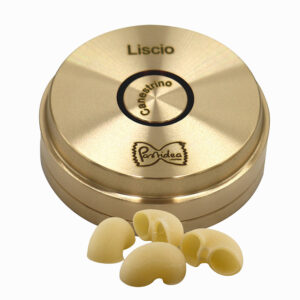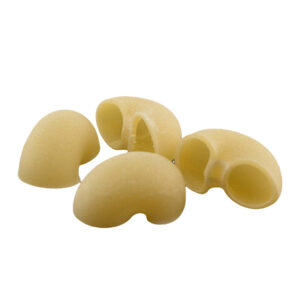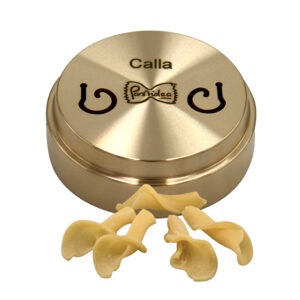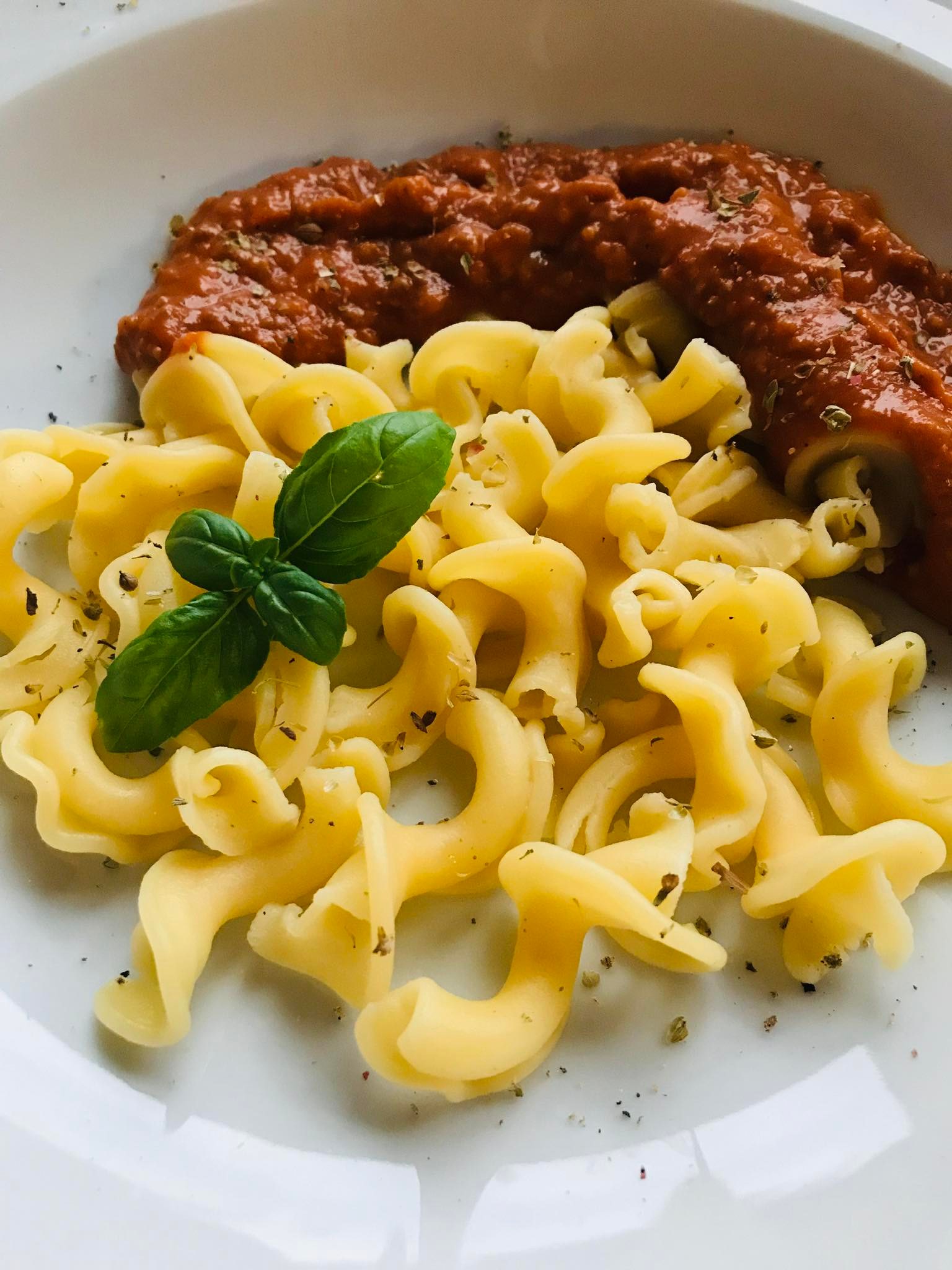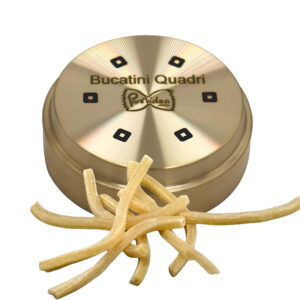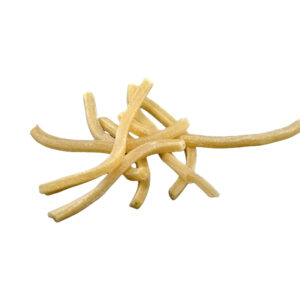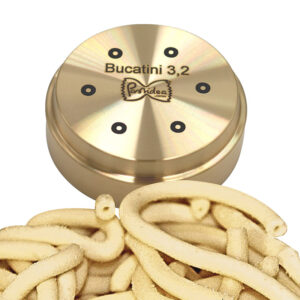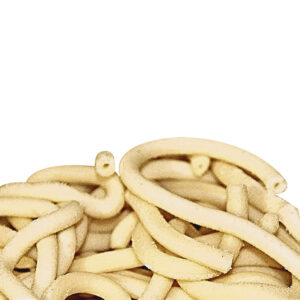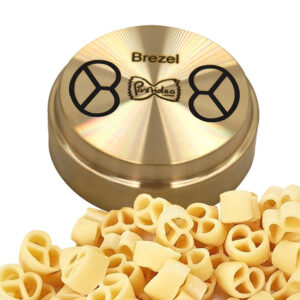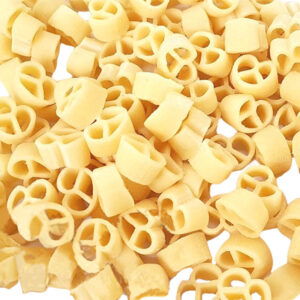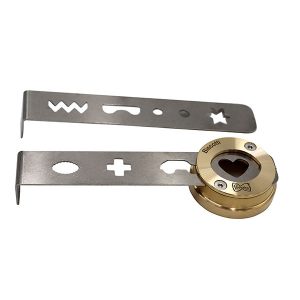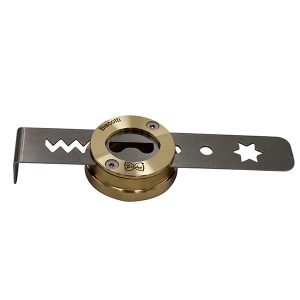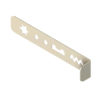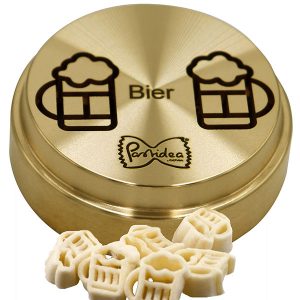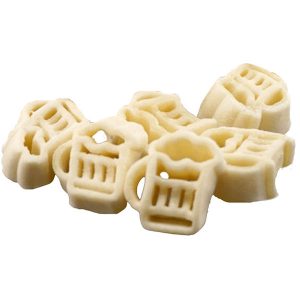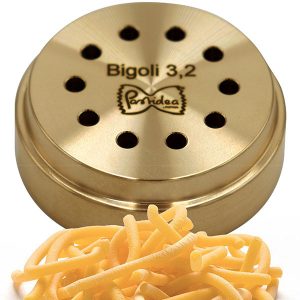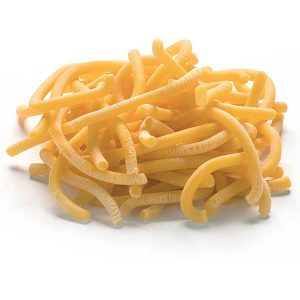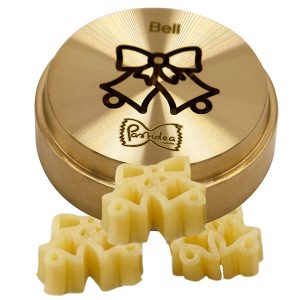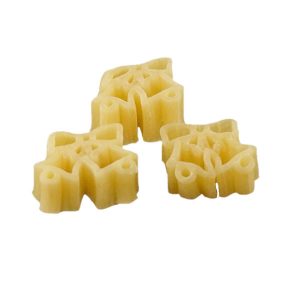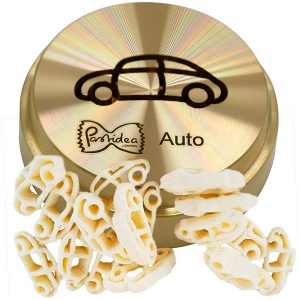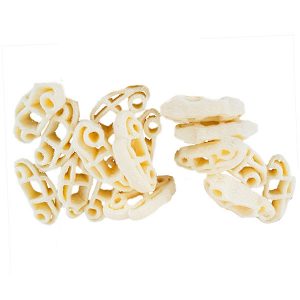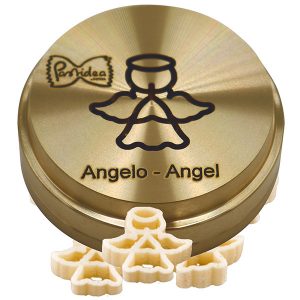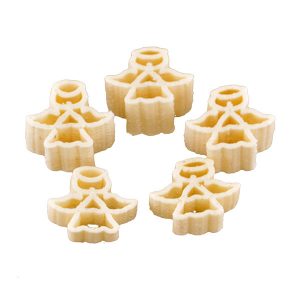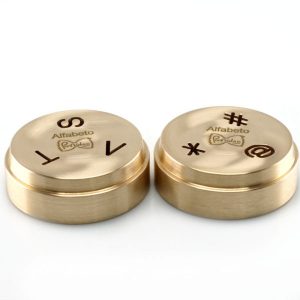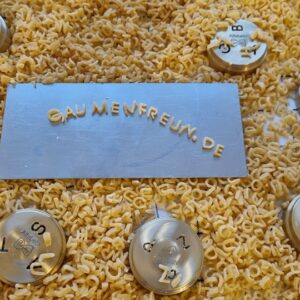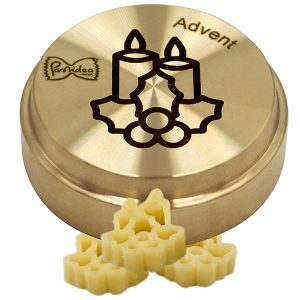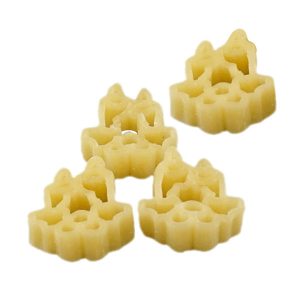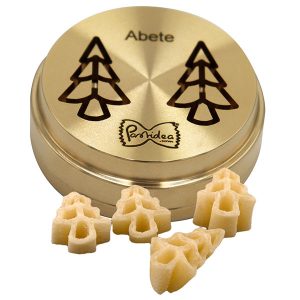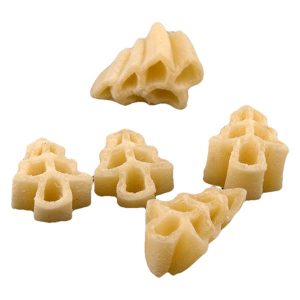35,60 € incl. VAT plus shipping costs
VAT included
excl. Shipping Rate
Die made of bronze Canestrino liscio / cup smooth. A canestro translates as basket. The -ino at the end makes it a small basket. This die is similar to the Canestro, just a little smaller. This size makes it ideal for pasta salad. Or as a side dish or a complete pasta dish. Although the canestrino is a tube pasta, it can be dried easily (provided the drying conditions are right). It is a two-part die. You should open and divide them very quickly after making pasta, then cleaning them is very easy. Here in the “liscio” version, i.e. with a smooth surface. The noodle is also available “rigato”, meaning with grooves. Pasta insert for Kenwood AT910, AX910, KAX910ME, PP510, KAX92.AO, KAX91.A0ME. With an adapter, the die can be used in many other pasta machines, e.g. Philips Pastamaker Avance, Philips Viva, KitchenAid, Simac, Ariete, Unold, La Fattorina, Firmar, TR50, Häussler, Korngold, Omega. The die is delivered together with a transparent transport protection box. Why bronze: Bronze dies were the traditional way of making pasta. The pasta made “al bronzo” can only be found rarely and usually only in selected delicatessens. By pressing the pasta dough through the bronze matrices, the surface of the pasta is slightly roughened at the same time, making the pasta easier to grip. This allows the pasta to better absorb the sauce, flavors and spices later on. Would you like to learn more about bronze matrices? Then we recommend this article to you here. Recipe: It is recommended to use durum wheat semolina, enough cold liquid such as water and/or egg. The dough should be kneaded for about 8-10 minutes, this is the only way the gluten from the durum wheat can fully develop. The result should be a moist, crumbly dough. You can find a standard recipe for our matrices here. The matrices can also be used to produce gluten-free pasta. Sustainability: The format of the pastide matrices was originally designed for the Kenwood Pastafresca. By using reducing rings, the bronze matrices can be used on almost all other common pasta machines. All you need is an adapter that fits the machine. This means that even if over time the pasta machine is replaced by a different model due to a defect or for other reasons: the bronze die remains and can continue to be used in the future. Please note: Please note that the matrices may have small dark spots due to the material and production. This is due to the material and does not affect the function in any way. The matrices are not dishwasher safe. Should be dried immediately after cleaning to avoid water stains.
32,90 € incl. VAT plus shipping costs
VAT included
excl. Shipping Rate
Bronze Calla die. This die from Pastidea is particularly elegant. The calla, which belongs to the dragon root genus, looks good as a pasta, for example as a side dish or in a pasta salad. It always runs a little slow at the beginning, but once the die gets warm it runs very well and becomes particularly pretty. Pasta insert for Kenwood AT910, AX910, KAX910ME, PP510, KAX92.AO, KAX91.A0ME. With an adapter, the die can be used in many other pasta machines, e.g. Philips Pastamaker Avance, Philips Viva, KitchenAid, Simac, Ariete, Unold, La Fattorina, Firmar, TR50, Häussler, Korngold, Omega. The die is delivered together with a transparent transport protection box. Why bronze: Bronze dies were the traditional way of making pasta. The pasta made “al bronzo” can only be found rarely and usually only in selected delicatessens. By pressing the pasta dough through the bronze matrices, the surface of the pasta is slightly roughened at the same time, making the pasta easier to grip. This allows the pasta to better absorb the sauce, flavors and spices later on. Would you like to learn more about bronze matrices? Then we recommend this article to you here. Recipe: It is recommended to use durum wheat semolina, enough cold liquid such as water and/or egg. The dough should be kneaded for about 8-10 minutes, this is the only way the gluten from the durum wheat can fully develop. The result should be a moist, crumbly dough. You can find a standard recipe for our matrices here. The matrices can also be used to produce gluten-free pasta. Sustainability: The format of the pastide matrices was originally designed for the Kenwood Pastafresca. By using reducing rings, the bronze matrices can be used on almost all other common pasta machines. All you need is an adapter that fits the machine. This means that even if over time the pasta machine is replaced by a different model due to a defect or for other reasons: the bronze die remains and can continue to be used in the future. Please note: Please note that the matrices may have small dark spots due to the material and production. This is due to the material and does not affect the function in any way. The matrices are not dishwasher safe. Should be dried immediately after cleaning to avoid water stains.
32,90 € incl. VAT plus shipping costs
VAT included
excl. Shipping Rate
Bronze Bucatini quadri square die, 3 mm wide, 1 mm thin. Bucatini is very large spaghetti, but with a hole in the middle (bucatini has the Italian word buco = hole). These bucatini are not classic round, but rather have a square shape. The Italians are very proud of their bucatini, you can find them all over Italy. Many say they come from Sicily, but I have also heard in the Rome area that they are typical of the region. Bucatini are very long pasta, if you let them out 30 cm long you are doing everything right. They are often served with rich sauces such as an Amatriciana or a Carbonara. But you can also find many vegetable sauces, for example with broccoli, on the menu in Italian restaurants. There is another special feature that you should know: In Germany people eat macaroni or macaroni with a smaller diameter than in Italy, 0,3 - 0,5 cm diameter is the average for macaroni in Germany (in Italy, however, approx. 1 cm ). This Italian bucatini is very close to the German macaroni that is so popular with children. You just have to cut them shorter. And you shouldn't talk about it too loudly, because Italians don't like the change in pasta terms. But here we are between ourselves, please don't tell anyone :-) Pasta insert for Kenwood AT910, AX910, KAX910ME, PP510, KAX92.AO, KAX91.A0ME. With an adapter, the die can be used in many other pasta machines, e.g. Philips Pastamaker Avance, Philips Viva, KitchenAid, Simac, Ariete, Unold, La Fattorina, Firmar, TR50, Häussler, Korngold, Omega. The die is delivered together with a transparent transport protection box. Why bronze: Bronze dies were the traditional way of making pasta. The pasta made “al bronzo” can only be found rarely and usually only in selected delicatessens. By pressing the pasta dough through the bronze matrices, the surface of the pasta is slightly roughened at the same time, making the pasta easier to grip. This allows the pasta to better absorb the sauce, flavors and spices later on. Would you like to learn more about bronze matrices? Then we recommend this article to you here. Recipe: It is recommended to use durum wheat semolina, enough cold liquid such as water and/or egg. The dough should be kneaded for about 8-10 minutes, this is the only way the gluten from the durum wheat can fully develop. The result should be a moist, crumbly dough. You can find a standard recipe for our matrices here. The matrices can also be used to produce gluten-free pasta. Sustainability: The format of the pastide matrices was originally designed for the Kenwood Pastafresca. By using reducing rings, the bronze matrices can be used on almost all other common pasta machines. All you need is an adapter that fits the machine. This means that even if over time the pasta machine is replaced by a different model due to a defect or for other reasons: the bronze die remains and can continue to be used in the future. Please note: Please note that the matrices may have small dark spots due to the material and production. This is due to the material and does not affect the function in any way. The matrices are not dishwasher safe. Should be dried immediately after cleaning to avoid water stains.
32,90 € incl. VAT plus shipping costs
VAT included
excl. Shipping Rate
Bucatini bronze die 3,2 mm. Bucatini is very large spaghetti, but with a hole in the middle (bucatini has the Italian word buco = hole). The Italians are very proud of their bucatini, you can find them all over Italy. Many say they come from Sicily, but I have also heard in the Rome area that they are typical of the region. Bucatini are very long pasta, if you let them out 30 cm long you are doing everything right. They are often served with rich sauces such as an Amatriciana or a Carbonara. But you can also find many vegetable sauces, for example with broccoli, on the menu in Italian restaurants. There is another special feature that you should know: In Germany people eat macaroni or macaroni with a smaller diameter than in Italy, 0,3 - 0,5 cm diameter is the average for macaroni in Germany (in Italy, however, approx. 1 cm ). This Italian bucatini is very close to the German macaroni that is so popular with children. You just have to cut them shorter. And you shouldn't talk about it too loudly, because Italians don't like the change in pasta terms. But here we are between ourselves, please don't tell anyone :-) Pasta insert for Kenwood AT910, AX910, KAX910ME, PP510, KAX92.AO, KAX91.A0ME. With an adapter, the die can be used in many other pasta machines, e.g. Philips Pastamaker Avance, Philips Viva, KitchenAid, Simac, Ariete, Unold, La Fattorina, Firmar, TR50, Häussler, Korngold, Omega. The die is delivered together with a transparent transport protection box. Why bronze: Bronze dies were the traditional way of making pasta. The pasta made “al bronzo” can only be found rarely and usually only in selected delicatessens. By pressing the pasta dough through the bronze matrices, the surface of the pasta is slightly roughened at the same time, making the pasta easier to grip. This allows the pasta to better absorb the sauce, flavors and spices later on. Would you like to learn more about bronze matrices? Then we recommend this article to you here. Recipe: It is recommended to use durum wheat semolina, enough cold liquid such as water and/or egg. The dough should be kneaded for about 8-10 minutes, this is the only way the gluten from the durum wheat can fully develop. The result should be a moist, crumbly dough. You can find a standard recipe for our matrices here. The matrices can also be used to produce gluten-free pasta. Sustainability: The format of the pastide matrices was originally designed for the Kenwood Pastafresca. By using reducing rings, the bronze matrices can be used on almost all other common pasta machines. All you need is an adapter that fits the machine. This means that even if over time the pasta machine is replaced by a different model due to a defect or for other reasons: the bronze die remains and can continue to be used in the future. Please note: Please note that the matrices may have small dark spots due to the material and production. This is due to the material and does not affect the function in any way. The matrices are not dishwasher safe. Should be dried immediately after cleaning to avoid water stains.
32,90 € incl. VAT plus shipping costs
VAT included
excl. Shipping Rate
Bronze pretzel die, not just for Oktoberfest. While strolling through Stuttgart's Königsstraße we passed the Brezelhäusle and thought a Swabian pretzel could also be a nice noodle shape. In the afternoon we told Pastidea about our idea. We received the first sketch that same evening. The first motif matrix from Pastidea was created. Pasta insert for Kenwood AT910, AX910, KAX910ME, PP510, KAX92.AO, KAX91.A0ME. With an adapter, the die can be used in many other pasta machines, e.g. Philips Pastamaker Avance, Philips Viva, KitchenAid, Simac, Ariete, Unold, La Fattorina, Firmar, TR50, Häussler, Korngold, Omega. The die is delivered together with a transparent transport protection box. Why bronze: Bronze dies were the traditional way of making pasta. The pasta made “al bronzo” can only be found rarely and usually only in selected delicatessens. By pressing the pasta dough through the bronze matrices, the surface of the pasta is slightly roughened at the same time, making the pasta easier to grip. This allows the pasta to better absorb the sauce, flavors and spices later on. Would you like to learn more about bronze matrices? Then we recommend this article to you here. Recipe: It is recommended to use durum wheat semolina, enough cold liquid such as water and/or egg. The dough should be kneaded for about 8-10 minutes, this is the only way the gluten from the durum wheat can fully develop. The result should be a moist, crumbly dough. You can find a standard recipe for our matrices here. The matrices can also be used to produce gluten-free pasta. Sustainability: The format of the pastide matrices was originally designed for the Kenwood Pastafresca. By using reducing rings, the bronze matrices can be used on almost all other common pasta machines. All you need is an adapter that fits the machine. This means that even if over time the pasta machine is replaced by a different model due to a defect or for other reasons: the bronze die remains and can continue to be used in the future. Please note: Please note that the matrices may have small dark spots due to the material and production. This is due to the material and does not affect the function in any way. The matrices are not dishwasher safe. Should be dried immediately after cleaning to avoid water stains.
47,10 € incl. VAT plus shipping costs
VAT included
excl. Shipping Rate
Bronze biscotti/cookies/pastry die with two push bars. This biscuit mold is versatile. A few application examples: a.) Classic shortbread cookies: Make the dough externally (preferably the family recipe as always), cool the dough in the refrigerator so that it hardens. Let the chilled dough pass through the die and bake. Attention: Please do not be surprised if the push rod initially lies loosely in the die. As soon as the dough comes out, it is firmly fixed. b.) Grissini dough: There are two holes on push rod 1. This can also be used to let breadstick dough pass through (dough is also made externally, only put into the machine to be dispensed). c.) Shortcrust pastry/cookie cutter dough: I have also had good experiences with this. The little hearts on push bar 2 were particularly impressive here. To do this, make the cookie dough externally, cool it, then put it into the machine for delivery. These little hearts were exciting because they were so tiny. A big bowl of these incredibly tiny hearts is a treat. Pasta insert for Kenwood AT910, AX910, KAX910ME, PP510, KAX92.AO, KAX91.A0ME. With an adapter, the die can be used in many other pasta machines, e.g. Philips Pastamaker Avance, Philips Viva, KitchenAid, Simac, Ariete, Unold, La Fattorina, Firmar, TR50, Häussler, Korngold, Omega. The die is delivered together with a transparent transport protection box. Why bronze: Bronze dies were the traditional way of making pasta. The pasta made “al bronzo” can only be found rarely and usually only in selected delicatessens. By pressing the pasta dough through the bronze matrices, the surface of the pasta is slightly roughened at the same time, making the pasta easier to grip. This allows the pasta to better absorb the sauce, flavors and spices later on. Would you like to learn more about bronze matrices? Then we recommend this article to you here. Recipe: It is recommended to use durum wheat semolina, enough cold liquid such as water and/or egg. The dough should be kneaded for about 8-10 minutes, this is the only way the gluten from the durum wheat can fully develop. The result should be a moist, crumbly dough. You can find a standard recipe for our matrices here. The matrices can also be used to produce gluten-free pasta. Sustainability: The format of the pastide matrices was originally designed for the Kenwood Pastafresca. By using reducing rings, the bronze matrices can be used on almost all other common pasta machines. All you need is an adapter that fits the machine. This means that even if over time the pasta machine is replaced by a different model due to a defect or for other reasons: the bronze die remains and can continue to be used in the future. Please note: Please note that the matrices may have small dark spots due to the material and production. This is due to the material and does not affect the function in any way. The matrices are not dishwasher safe. Should be dried immediately after cleaning to avoid water stains.
36,60 € incl. VAT plus shipping costs
VAT included
excl. Shipping Rate
Bronze biscotti / shortbread biscuit die with a push bar. Pasta insert for Kenwood AT910, AX910, KAX910ME, PP510, KAX92.AO, KAX91.A0ME. With an adapter, the die can be used in many other pasta machines, e.g. Philips Pastamaker Avance, Philips Viva, KitchenAid, Simac, Ariete, Unold, La Fattorina, Firmar, TR50, Häussler, Korngold, Omega. The die is delivered together with a transparent transport protection box. Why bronze: Bronze dies were the traditional way of making pasta. The pasta made “al bronzo” can only be found rarely and usually only in selected delicatessens. By pressing the pasta dough through the bronze matrices, the surface of the pasta is slightly roughened at the same time, making the pasta easier to grip. This allows the pasta to better absorb the sauce, flavors and spices later on. Would you like to learn more about bronze matrices? Then we recommend this article to you here. Recipe: It is recommended to use durum wheat semolina, enough cold liquid such as water and/or egg. The dough should be kneaded for about 8-10 minutes, this is the only way the gluten from the durum wheat can fully develop. The result should be a moist, crumbly dough. You can find a standard recipe for our matrices here. The matrices can also be used to produce gluten-free pasta. Sustainability: The format of the pastide matrices was originally designed for the Kenwood Pastafresca. By using reducing rings, the bronze matrices can be used on almost all other common pasta machines. All you need is an adapter that fits the machine. This means that even if over time the pasta machine is replaced by a different model due to a defect or for other reasons: the bronze die remains and can continue to be used in the future. Please note: Please note that the matrices may have small dark spots due to the material and production. This is due to the material and does not affect the function in any way. The matrices are not dishwasher safe. Should be dried immediately after cleaning to avoid water stains.
32,90 € incl. VAT plus shipping costs
VAT included
excl. Shipping Rate
Bronze Beer Oktoberfest Die. Pasta insert for Kenwood AT910, AX910, KAX910ME, PP510, KAX92.AO, KAX91.A0ME. With an adapter, the die can be used in many other pasta machines, e.g. Philips Pastamaker Avance, Philips Viva, KitchenAid, Simac, Ariete, Unold, La Fattorina, Firmar, TR50, Häussler, Korngold, Omega. The die is delivered together with a transparent transport protection box. Why bronze: Bronze dies were the traditional way of making pasta. The pasta made “al bronzo” can only be found rarely and usually only in selected delicatessens. By pressing the pasta dough through the bronze matrices, the surface of the pasta is slightly roughened at the same time, making the pasta easier to grip. This allows the pasta to better absorb the sauce, flavors and spices later on. Would you like to learn more about bronze matrices? Then we recommend this article to you here. Recipe: It is recommended to use durum wheat semolina, enough cold liquid such as water and/or egg. The dough should be kneaded for about 8-10 minutes, this is the only way the gluten from the durum wheat can fully develop. The result should be a moist, crumbly dough. You can find a standard recipe for our matrices here. The matrices can also be used to produce gluten-free pasta. Sustainability: The format of the pastide matrices was originally designed for the Kenwood Pastafresca. By using reducing rings, the bronze matrices can be used on almost all other common pasta machines. All you need is an adapter that fits the machine. This means that even if over time the pasta machine is replaced by a different model due to a defect or for other reasons: the bronze die remains and can continue to be used in the future. Please note: Please note that the matrices may have small dark spots due to the material and production. This is due to the material and does not affect the function in any way. The matrices are not dishwasher safe. Should be dried immediately after cleaning to avoid water stains.
32,90 € incl. VAT plus shipping costs
VAT included
excl. Shipping Rate
Bronze Bigoli die, 3,2 mm diameter. Ultimately, bigoli are nothing more than very thick spaghetti. They are found mainly in the Veneto area. When pronounced, they sound like this: Biiiiii-go-li. In the past, they were made by hand, which meant rolling out the firm pasta dough with a rolling pin, rolling the dough into a roll and then cutting it into very fine cuts with a sharp knife. In order to reduce the effort, the Bigolaro was invented (you can already see the similarity to the Bigolis from the name). It was a press shaped like a silicone cartridge. The dough is filled into the cartridge and there is a bronze matrix at the bottom, e.g. B. for bigoli and then you have to turn from above to press the dough through. I'll link the Bigolaro here so you can take a look: Bigolaro. Quite a lot of work! This is possible with our matrix in combination with e.g. much more convenient and easier with the Philips pasta maker. Bigolis are traditionally eaten fresh as egg noodles. Incidentally, it is very rare to find it as a pasta in the supermarket. They are also becoming more and more of a rarity in Italy. This means that if you want to prepare bigolis, you really have to make them by hand as described above or you need this matrix. Pasta insert for Kenwood AT910, AX910, KAX910ME, PP510, KAX92.AO, KAX91.A0ME. With an adapter, the die can be used in many other pasta machines, e.g. Philips Pastamaker Avance, Philips Viva, KitchenAid, Simac, Ariete, Unold, La Fattorina, Firmar, TR50, Häussler, Korngold, Omega. The die is delivered together with a transparent transport protection box. Why bronze: Bronze dies were the traditional way of making pasta. The pasta made “al bronzo” can only be found rarely and usually only in selected delicatessens. By pressing the pasta dough through the bronze matrices, the surface of the pasta is slightly roughened at the same time, making the pasta easier to grip. This allows the pasta to better absorb the sauce, flavors and spices later on. Would you like to learn more about bronze matrices? Then we recommend this article to you here. Recipe: It is recommended to use durum wheat semolina, enough cold liquid such as water and/or egg. The dough should be kneaded for about 8-10 minutes, this is the only way the gluten from the durum wheat can fully develop. The result should be a moist, crumbly dough. You can find a standard recipe for our matrices here. The matrices can also be used to produce gluten-free pasta. Sustainability: The format of the pastide matrices was originally designed for the Kenwood Pastafresca. By using reducing rings, the bronze matrices can be used on almost all other common pasta machines. All you need is an adapter that fits the machine. This means that even if over time the pasta machine is replaced by a different model due to a defect or for other reasons: the bronze die remains and can continue to be used in the future. Please note: Please note that the matrices may have small dark spots due to the material and production. This is due to the material and does not affect the function in any way. The matrices are not dishwasher safe. Should be dried immediately after cleaning to avoid water stains.
35,60 € incl. VAT plus shipping costs
VAT included
excl. Shipping Rate
Die made of bronze bells Christmas bells from Pastidea. Pasta insert for Kenwood AT910, AX910, KAX910ME, PP510, KAX92.AO, KAX91.A0ME. With an adapter, the die can be used in many other pasta machines, e.g. Philips Pastamaker Avance, Philips Viva, KitchenAid, Simac, Ariete, Unold, La Fattorina, Firmar, TR50, Häussler, Korngold, Omega. The die is delivered together with a transparent transport protection box. Why bronze: Bronze dies were the traditional way of making pasta. The pasta made “al bronzo” can only be found rarely and usually only in selected delicatessens. By pressing the pasta dough through the bronze matrices, the surface of the pasta is slightly roughened at the same time, making the pasta easier to grip. This allows the pasta to better absorb the sauce, flavors and spices later on. Would you like to learn more about bronze matrices? Then we recommend this article to you here. Recipe: It is recommended to use durum wheat semolina, enough cold liquid such as water and/or egg. The dough should be kneaded for about 8-10 minutes, this is the only way the gluten from the durum wheat can fully develop. The result should be a moist, crumbly dough. You can find a standard recipe for our matrices here. The matrices can also be used to produce gluten-free pasta. Sustainability: The format of the pastide matrices was originally designed for the Kenwood Pastafresca. By using reducing rings, the bronze matrices can be used on almost all other common pasta machines. All you need is an adapter that fits the machine. This means that even if over time the pasta machine is replaced by a different model due to a defect or for other reasons: the bronze die remains and can continue to be used in the future. Please note: Please note that the matrices may have small dark spots due to the material and production. This is due to the material and does not affect the function in any way. The matrices are not dishwasher safe. Should be dried immediately after cleaning to avoid water stains.
35,60 € incl. VAT plus shipping costs
VAT included
excl. Shipping Rate
Bronze car die. Pasta insert for Kenwood AT910, AX910, KAX910ME, PP510, KAX92.AO, KAX91.A0ME. With an adapter, the die can be used in many other pasta machines, e.g. Philips Pastamaker Avance, Philips Viva, KitchenAid, Simac, Ariete, Unold, La Fattorina, Firmar, TR50, Häussler, Korngold, Omega. The die is delivered together with a transparent transport protection box. Why bronze: Bronze matrices were the traditional way of making pasta. The pasta made “al bronzo” can only be found rarely and usually only in selected delicatessens. By pressing the pasta dough through the bronze dies, the surface of the pasta is slightly roughened and the pasta becomes more grippy. This allows the pasta to absorb the sauce, flavors and spices better later Recipe: It is recommended to use durum wheat semolina, sufficiently cold liquid such as water and/or egg. The dough should be kneaded for about 8-10 minutes so that the gluten from the durum wheat can fully develop. The result should be a moist, crumbly dough. We recommend the following standard recipe for our matrices: Ingredients: 250 g durum wheat semolina or Semola rimacinata Select ONE of the following ingredients: 100 ml cold water or 110 ml liquid consisting of two eggs, the rest of the water, lightly whisked Instructions: Please only use cold liquids . Avoid flour, replace it with semolina. Use binding agents such as xanthan gum, gluten, etc. only to a limited extent, a maximum of 1 teaspoon per 500 grams of dry ingredients. Otherwise the dough will be too firm and the dies could break. If you knead the dough for longer or let it rest, the gluten will develop on its own. You can recognize a good pasta dough by the fact that it is moist and crumbly. The production of gluten-free pasta is also possible with the matrices. Sustainability: The format of the Pastidea matrices was originally designed for the Kenwood Pastafresca. By using reducing rings, the bronze matrices can be used on almost all other common pasta machines. All you need is an adapter that fits the machine. This means that even if over time the pasta machine is replaced by a different model due to a defect or for other reasons: the bronze die remains and can continue to be used in the future. Storage: Do you have several bronze matrices and are you looking for storage to protect the matrix from dust and darkening due to the effects of light? Then we recommend our storage systems, which you can also find in our range. Please note: Please note that the matrices may have small dark spots due to the material and production. This is due to the material and does not affect the function in any way. The matrices are not dishwasher safe. Should be dried immediately after cleaning to avoid water stains.
35,60 € incl. VAT plus shipping costs
VAT included
excl. Shipping Rate
Bronze die Angel Angelo - Christmas This die has a special meaning. In spring 2019, Silvia said goodbye completely unexpectedly with a post in our Facebook group. She was terminally ill, the therapy wouldn't work, she'd be gone. We were floored by this calm announcement. Silvia was a valued member of our group, the group mourned together. During this time, Pastidea designed this angel matrix for us and dedicated it to Silvia. In the first versions there was also the engraving "Silvia" on the die. With an adapter, the die can be used in many other pasta machines, e.g. Philips Pastamaker Avance, Philips Viva, KitchenAid, Simac, Ariete, Unold, La Fattorina, Firmar, TR50, Häussler, Korngold, Omega Why bronze: Bronze matrices were the traditional way of making pasta. The pasta made “al bronzo” can only be found rarely and usually only in selected delicatessens. By pressing the pasta dough through the bronze dies, the surface of the pasta is slightly roughened and the pasta becomes more grippy. This allows the pasta to absorb the sauce, flavors and spices better later Recipe: It is recommended to use durum wheat semolina, sufficiently cold liquid such as water and/or egg. The dough should be kneaded for about 8-10 minutes so that the gluten from the durum wheat can fully develop. The result should be a moist, crumbly dough. We recommend the following standard recipe for our matrices: Ingredients: 250 g durum wheat semolina or Semola rimacinata Select ONE of the following ingredients: 100 ml cold water or 110 ml liquid consisting of two eggs, the rest of the water, lightly whisked Instructions: Please only use cold liquids . Avoid flour, replace it with semolina. Use binding agents such as xanthan gum, gluten, etc. only to a limited extent, a maximum of 1 teaspoon per 500 grams of dry ingredients. Otherwise the dough will be too firm and the dies could break. If you knead the dough for longer or let it rest, the gluten will develop on its own. You can recognize a good pasta dough by the fact that it is moist and crumbly. The production of gluten-free pasta is also possible with the matrices. Sustainability: The format of the Pastidea matrices was originally designed for the Kenwood Pastafresca. By using reducing rings, the bronze matrices can be used on almost all other common pasta machines. All you need is an adapter that fits the machine. This means that even if over time the pasta machine is replaced by a different model due to a defect or for other reasons: the bronze die remains and can continue to be used in the future. Storage: Do you have several bronze matrices and are you looking for storage to protect the matrix from dust and darkening due to the effects of light? Then we recommend our storage systems, which you can also find in our range. Please note: Please note that the matrices may have small dark spots due to the material and production. This is due to the material and does not affect the function in any way. The matrices are not dishwasher safe. Should be dried immediately after cleaning to avoid water stains.
57,60 € incl. VAT plus shipping costs
VAT included
excl. Shipping Rate
Bronze die Alphabet TSV symbols (Hashtag…). Pasta insert for Kenwood AT910, AX910, KAX910ME, PP510, KAX92.AO, KAX91.A0ME. With an adapter, the die can be used in many other pasta machines, e.g. Philips Pastamaker Avance, Philips Viva, KitchenAid, Simac, Ariete, Unold, La Fattorina, Firmar, TR50, Häussler, Korngold, Omega. The die is delivered together with a transparent transport protection box. Why bronze: Bronze dies were the traditional way of making pasta. The pasta made “al bronzo” can only be found rarely and usually only in selected delicatessens. By pressing the pasta dough through the bronze matrices, the surface of the pasta is slightly roughened at the same time, making the pasta easier to grip. This allows the pasta to better absorb the sauce, flavors and spices later on. Would you like to learn more about bronze matrices? Then we recommend this article to you here. Recipe: It is recommended to use durum wheat semolina, enough cold liquid such as water and/or egg. The dough should be kneaded for about 8-10 minutes, this is the only way the gluten from the durum wheat can fully develop. The result should be a moist, crumbly dough. You can find a standard recipe for our matrices here. The matrices can also be used to produce gluten-free pasta. Sustainability: The format of the pastide matrices was originally designed for the Kenwood Pastafresca. By using reducing rings, the bronze matrices can be used on almost all other common pasta machines. All you need is an adapter that fits the machine. This means that even if over time the pasta machine is replaced by a different model due to a defect or for other reasons: the bronze die remains and can continue to be used in the future. Please note: Please note that the matrices may have small dark spots due to the material and production. This is due to the material and does not affect the function in any way. The matrices are not dishwasher safe. Should be dried immediately after cleaning to avoid water stains.
35,60 € incl. VAT plus shipping costs
VAT included
excl. Shipping Rate
Bronze die from Pastidea Advent. Pasta insert for Kenwood AT910, AX910, KAX910ME, PP510, KAX92.AO, KAX91.A0ME. With an adapter, the die can be used in many other pasta machines, e.g. Philips Pastamaker Avance, Philips Viva, KitchenAid, Simac, Ariete, Unold, La Fattorina, Firmar, TR50, Häussler, Korngold, Omega. The die is delivered together with a transparent transport protection box. Why bronze: Bronze matrices were the traditional way of making pasta. The pasta made “al bronzo” can only be found rarely and usually only in selected delicatessens. By pressing the pasta dough through the bronze dies, the surface of the pasta is slightly roughened and the pasta becomes more grippy. This allows the pasta to absorb the sauce, flavors and spices better later Recipe: It is recommended to use durum wheat semolina, sufficiently cold liquid such as water and/or egg. The dough should be kneaded for about 8-10 minutes so that the gluten from the durum wheat can fully develop. The result should be a moist, crumbly dough. We recommend the following standard recipe for our matrices: Ingredients: 250 g durum wheat semolina or Semola rimacinata Select ONE of the following ingredients: 100 ml cold water or 110 ml liquid consisting of two eggs, the rest of the water, lightly whisked Instructions: Please only use cold liquids . Avoid flour, replace it with semolina. Use binding agents such as xanthan gum, gluten, etc. only to a limited extent, a maximum of 1 teaspoon per 500 grams of dry ingredients. Otherwise the dough will be too firm and the dies could break. If you knead the dough for longer or let it rest, the gluten will develop on its own. You can recognize a good pasta dough by the fact that it is moist and crumbly. The production of gluten-free pasta is also possible with the matrices. Sustainability: The format of the Pastidea matrices was originally designed for the Kenwood Pastafresca. By using reducing rings, the bronze matrices can be used on almost all other common pasta machines. All you need is an adapter that fits the machine. This means that even if over time the pasta machine is replaced by a different model due to a defect or for other reasons: the bronze die remains and can continue to be used in the future. Storage: Do you have several bronze matrices and are you looking for storage to protect the matrix from dust and darkening due to the effects of light? Then we recommend our storage systems, which you can also find in our range. Please note: Please note that the matrices may have small dark spots due to the material and production. This is due to the material and does not affect the function in any way. The matrices are not dishwasher safe. Should be dried immediately after cleaning to avoid water stains.
35,60 € incl. VAT plus shipping costs
VAT included
excl. Shipping Rate
Die made of bronze fir tree Abete. Pasta insert for Kenwood AT910, AX910, KAX910ME, PP510, KAX92.AO, KAX91.A0ME. With an adapter, the die can be used in many other pasta machines, e.g. Philips Pastamaker Avance, Philips Viva, KitchenAid, Simac, Ariete, Unold, La Fattorina, Firmar, TR50, Häussler, Korngold, Omega. The die is delivered together with a transparent transport protection box. Why bronze: Bronze dies were the traditional way of making pasta. The pasta made “al bronzo” can only be found rarely and usually only in selected delicatessens. By pressing the pasta dough through the bronze matrices, the surface of the pasta is slightly roughened at the same time, making the pasta easier to grip. This allows the pasta to better absorb the sauce, flavors and spices later on. Would you like to learn more about bronze matrices? Then we recommend this article to you here. Recipe: It is recommended to use durum wheat semolina, enough cold liquid such as water and/or egg. The dough should be kneaded for about 8-10 minutes, this is the only way the gluten from the durum wheat can fully develop. The result should be a moist, crumbly dough. You can find a standard recipe for our matrices here. The matrices can also be used to produce gluten-free pasta. Sustainability: The format of the pastide matrices was originally designed for the Kenwood Pastafresca. By using reducing rings, the bronze matrices can be used on almost all other common pasta machines. All you need is an adapter that fits the machine. This means that even if over time the pasta machine is replaced by a different model due to a defect or for other reasons: the bronze die remains and can continue to be used in the future. Please note: Please note that the matrices may have small dark spots due to the material and production. This is due to the material and does not affect the function in any way. The matrices are not dishwasher safe. Should be dried immediately after cleaning to avoid water stains.


